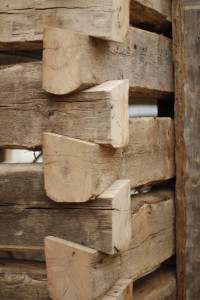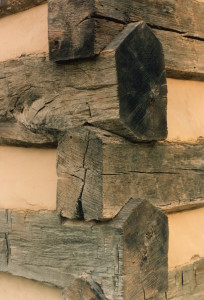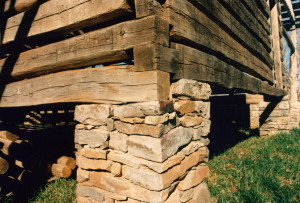There are three different types of corner notches on log cabins found here in the Mid-Atlantic states… the half-dovetail, the V-notch, and the square notch.
The half-dovetail and the V-notch are found on log homes and barns and even often on barns and other types of outbuildings. Whereas I have only seen the square notch used on supplemental farm buildings.
The half-dovetail, as seen above, I believe, is the most attractive of the three types of notches and offers the added benefit of ensuring that all of the rain that strikes the top of the notch drains out of the notch and to the exterior of the cabin. You would think it would be a difficult notch to make but I have found it easier to make than the V-notch and not much harder than the square notch.
The V-notch is perhaps slightly more common in old cabins. The top of each notch looks like a pointed roof of a house. I have heard some people refer to this notch as a saddle notch, but that name I reserve for the notch used out west where round logs are commonly used and thus rounded notches are created for them… which makes each notch look like a saddle. (I wouldn’t ever want to ride a horse with a saddle that was shaped like a pointed roof of a house)
And then finally, there is the square notch. A common choice among farmers wanting to get their barns up quickly and covered over with a large overhanging roof that would protect these notches from ever getting wet. The notches’ flat tops and bottoms invite rain in and don’t allow it drain out so rot would soon happen if left exposed to weather. These notches also offer no horizontal binding strength so each notch is “blind pegged” from above as each log is put in place. (blind pegged meaning that you don’t see the pegs)
So when it comes time to build your cabin… which notch will you use?
Originally posted 2015-08-13 13:37:07.




I’m not building a cabin,but I love looking at the different styles of notches….
Thanks Christy!
Yep, I agree… the joinery draws my eye every time!
…it’s the first thing I observe about a cabin.
Very informative…thanks. Question….After doing family research and finding my G-G-Grandfather’s 1850 Missouri log cabin, we were able to purchase it, have it dismantled and shipped west. When the metal siding was removed it was discovered that it had two different notches…some logs were V-notched and some were half-doved tail. That let our cabin dismantler to the conclusion that it had been re-constructed from two cabins. The owner of the farm said he was pretty sure the cabin had been moved from “the back 40” around turn of the century. He showed us where he believed it once stood. My ancestor was an immigrant from Switzerland. He married the “girl next door”…her parents were from France (ah ha…maybe the combined cabins were from these two properties). My question is…are different notches indicative of different areas or even countries of the immigrants? Or are log cabins solely Americana and their notches just methods of convenience? Thanks, Jayne
Hi Jayne,
What a great story!
Thank you for sharing!
The one detail that you didn’t provide was if the varying notches were mixed throughout the cabin, or if say the bottom half of the cabin was one way and then the top another… which the later would indicate a later addition of a second story by a different person.
But, I’ll assume they were mixed throughout.
It is possible your cabin was built from two different cabins. I’ve done that plenty of times myself. In this modern age of large machinery I can bring in cabins from two different counties or even two different states and combine them into one larger cabin. But, I’m not certain if I’ve ever seen an old cabin made from two cabins… but… I’ve seen plenty of cabins that were built new at the time and that made use of some of the logs from a cabin that previously sat on that same site (generally the original cabin was smaller and so the front and back of logs that were notched for floor joists are found in the ends of the newer larger cabin. My money is on that being the case with your cabin.
Without seeing your cabin I would venture to say your v-notch logs show more age on them. Possibly not if the original cabin was sided over.
The French are not noted for their log craftsmanship, the Swiss, that’s another story… masters with an axe they are, along with the Germans. I’ve seen a lot of diversity in notches within a small area of known similar immigrants, so notching is more of an individual preference than a national one.
I’d love to see a photo if you ever care to share.
Noah